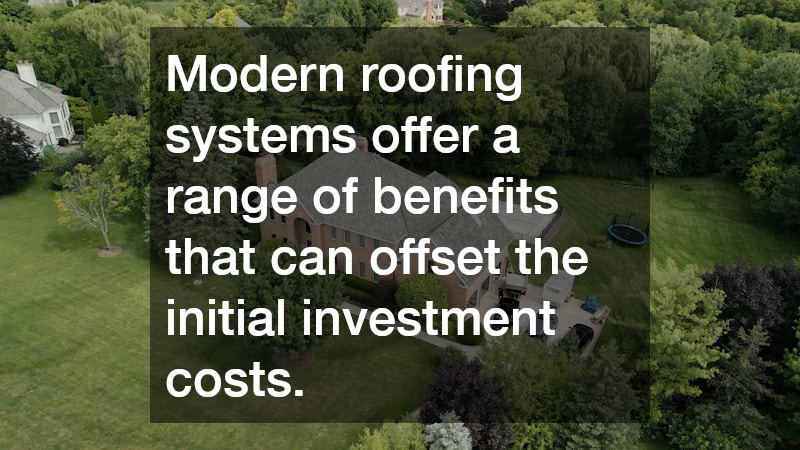This article explores the financial implications and advantages associated with modern roofing systems. It provides a comprehensive analysis of cost elements, environmental benefits, and long-term savings, helping homeowners make informed decisions. As improvements in technology and materials advance, modern roofing systems present numerous opportunities for both immediate and future gains.
What are the initial costs of modern roofing?
Material Costs
Modern roofing encompasses a variety of materials, each varying in cost and suitability for different climates and architectural styles. Materials such as metal, solar tiles, and synthetic shingles generally cost more upfront compared to traditional asphalt shingles, with prices depending on factors like durability and design. For instance, metal roofing can range from $120 to $900 per 100 square feet installed, making it a significant initial investment.
Comparisons between traditional and modern options highlight the longevity and performance benefits, which often justify the higher costs of modern materials. While traditional materials like asphalt may be less expensive initially, modern materials tend to offer better energy efficiency and require less maintenance over time, balancing the expenditure. Ultimately, selecting the right roofing material depends on the homeowner’s budget, aesthetic preference, and environmental considerations.
Homeowners should consider both the immediate financial outlay and the long-term benefits when selecting roofing materials. For example, although solar tiles may involve a substantial initial cost, they can contribute to significant energy savings and potential tax incentives down the line. By carefully weighing these factors, individuals can determine which options provide the best value for their specific needs.
Installation Expenses
The cost of installing modern roofing systems significantly depends on the complexity of the roof design and labor rates in the area. Labor costs typically represent a substantial portion of the total installation expense, with intricately designed roofs requiring more skilled labor and thus increasing costs. Professional installation ensures the longevity and performance of the roofing system, emphasizing the importance of investing in skilled workers.
Factors influencing installation pricing include roof pitch, accessibility, and the square footage of the area to be covered. In some regions, the availability of skilled labor can affect overall expenses, leading homeowners to sometimes pay a premium for experienced contractors. Despite the high initial costs, proper installation helps mitigate future repair expenses and supports the longevity of modern roofing systems.
The choice of contractor also impacts the cost and quality of installation. Selecting a reputable, experienced roofer ensures not only quality workmanship but also accurate cost estimates and potential cost-saving measures. Homeowners must conduct thorough research and possibly obtain multiple quotes to gauge a fair market price for installation, aligning it with their budgetary constraints.
Regional Price Variations
Geographic location plays a crucial role in determining the costs of modern roofing installation, with prices often varying significantly across regions. Costs can be higher in urban areas due to increased labor rates and material shipping costs, whereas rural areas might reflect lower price points. For instance, roofing material costs in coastal regions might differ due to the need for weather-resistant materials to withstand harsh maritime conditions.
The climate and common weather patterns of a region influence the type of roofing materials that are most suitable, thereby affecting cost considerations. In places with extreme weather conditions, more durable and resistant materials may be necessary, resulting in higher upfront expenses. Consequently, directing a part of the investment towards quality materials can offset increased maintenance expenses in areas prone to severe weather.
Understanding these regional variations allows homeowners to better anticipate the potential costs associated with modern roofing projects. By consulting local contractors and considering regional recommendations, individuals can make informed decisions that align with both their financial and climate needs. Comparing regional price differences also encourages a better assessment of value when planning a roofing project.
Are there long-term financial benefits?
Energy Efficiency Savings
Modern roofing systems are engineered to significantly improve energy efficiency, potentially reducing energy bills for homeowners. Energy-efficient materials, such as reflective or cool roofing, mitigate heat absorption, subsequently lowering the demand for air conditioning. Reduced energy consumption not only aligns with sustainable practices but also results in long-term financial savings.
In addition to the immediate benefits of lowered utility costs, homeowners may be eligible for government incentives or tax benefits designed to encourage energy-efficient home improvements. Programs like Energy Star provide rebates for compliant products, further boosting financial savings for energy-conscious investments. Over time, these savings can substantially counterbalance the initial costs associated with installing a modern roofing system.
The incorporation of solar panels into a roofing project exemplifies how homes can become energy producers rather than merely consumers. Homeowners who generate surplus energy can often sell this back to the grid, creating an additional revenue stream, and accelerating their return on investment. With utility costs projected to rise, investing in a roofing system that enhances energy efficiency becomes an economically prudent decision.
Durability and Low Maintenance Costs
Modern roofing materials are typically more durable and require less maintenance compared to traditional counterparts, leading to lower long-term costs. Metal roofs, for instance, can last 40-70 years, significantly outlasting asphalt shingles, which average 20 years. Their robust nature reduces the frequency and cost of repairs, offering homeowners peace of mind and financial predictability.
The resilience of these materials is a key factor in their cost-effectiveness; investing in quality roofing minimizes the risk of weather-related damage and the corresponding repair expenditures. Although the upfront investment is higher, the reduced need for regular maintenance lowers overall expenses consistent with modern roofing solutions. Regular maintenance of these durable materials often involves simple inspections and minor repairs, further confirming their cost-efficiency over time.
Modern roofing systems offer a range of benefits that can offset the initial investment costs. By considering factors such as materials, installation, energy savings, and environmental impacts, homeowners can make well-informed decisions that contribute positively to their finances and the environment. The evolution of roofing technologies continues to pave the way for more efficient, aesthetically pleasing, and environmentally friendly solutions, making them a prudent choice for forward-thinking homeowners.
